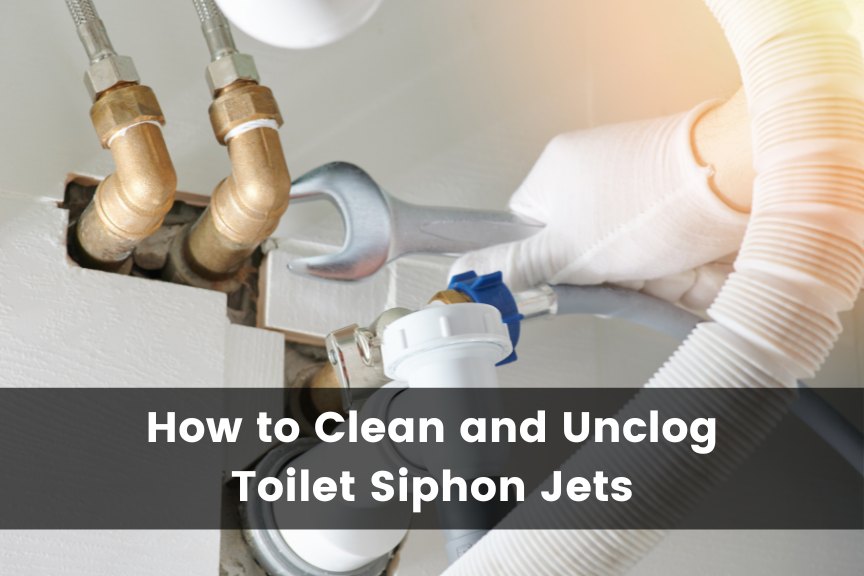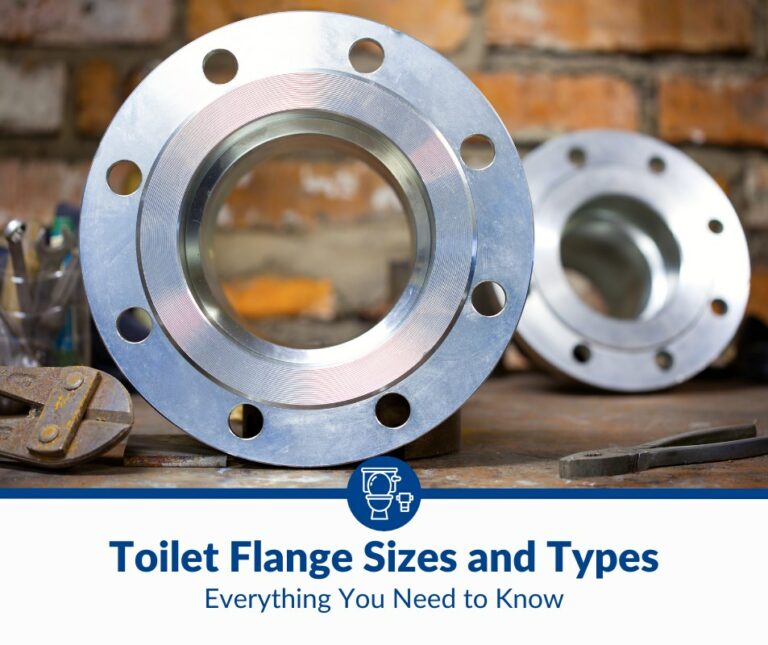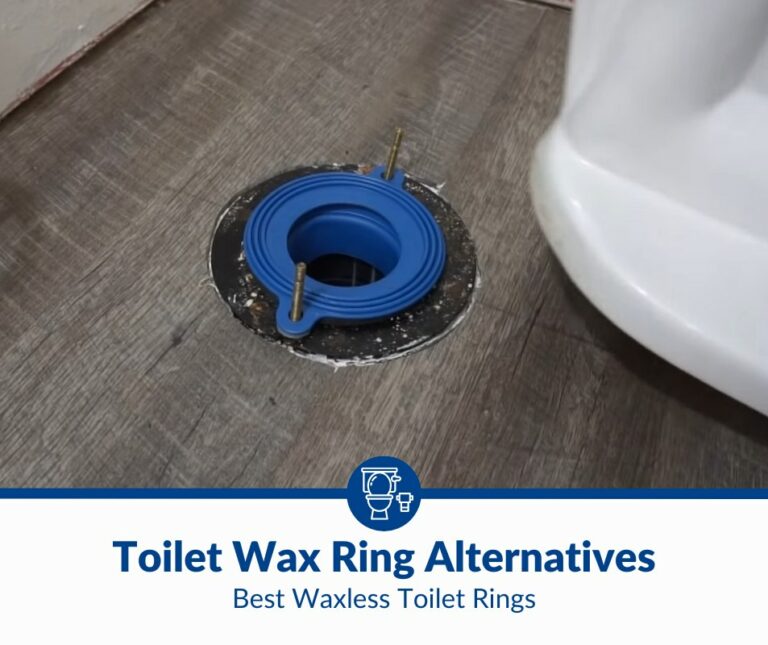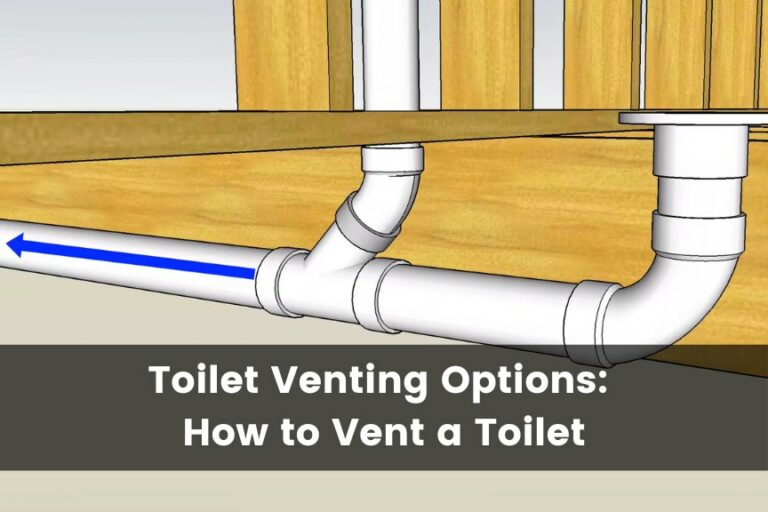How To Clean and Unclog Toilet Siphon Jets
A toilet siphon jet, located inside your toilet bowl, is there to relieve pressure after you flush. Over time, this jet can become clogged with flushed objects and minerals from hard water, causing your toilet to flush poorly. Luckily, cleaning your siphon jet is a simple process that only takes less than an hour.
You can clean and unclog toilet siphon jets by flushing water out and cleaning the jet to relieve pressure from debris. Let the cleaning solution sit for several minutes before using a wire to scrape the remaining clogs. To clean mineral deposits and dirt buildup, use a heavy-duty scrub.
This article will give you step-by-step instructions to unclog your jets and get your toilet back in working order. Keep reading to learn about the safest and most effective way to do so, and get some bonus tips and advice at the end.
1. Shut Off the Water Supply and Drain the Bowl
If you’re planning on giving your toilet a good cleaning, you’ll want to make sure you shut off the water supply first. Doing so will ensure that you don’t get sprayed with water while cleaning. It will also prevent any cleaner from getting into the water supply.
Follow these steps before cleaning your toilet:
- Locate the water shut-off valve. The valve is a stopper that should be behind your toilet.
- Turn the valve to the off position. You may need to use a wrench to turn it if it’s tight.
- Flush the toilet bowl. It’s easier to clean a toilet bowl if there’s no water in it. Draining the bowl also allows you to get rid of all the dirty water and start with a clean slate.
2. Check for Clogged Jets
The siphon jet hole is near the base of the toilet. Its function is to help move water from the bowl into the drain. Over time, siphon jets can become clogged with debris, and this can cause problems with flushing.
There are a few ways to check if your siphon jets are clogged:
- Take a look at the rim or base of your toilet. If you see any debris or buildup around the siphon jet holes, this could be causing the clog.
- If you cannot see the siphon jet, it may be covered by dirt or mineral deposit buildup.
- If you don’t see anything blocking the jet, it’s likely that the problem lies further down in your pipes.
- Flush your toilet and then hold a piece of paper over the jet holes. If the paper doesn’t get sucked down, then the jets are probably clogged.
What Causes Clogged Toilet Siphon Jets?
A toilet siphon jet is a small, powerful pump used to flush waste from the bowl. It’s usually located on the side of the toilet opposite the water tank. When it becomes clogged, sewage accumulates in this pump, causing it to stop working.
There are several potential causes of a clogged toilet siphon jet:
- Mineral buildup caused by hard water.
- A buildup of fecal matter in the pipe leading from the bowl to the sewer system.
- Flushing objects such as diapers and feminine hygiene products down the bowl.
- Poorly designed plumbing that doesn’t allow for enough flow through the siphon jet.
- Faulty flushing mechanisms that don’t clear waste properly after each use.
If you don’t unclog your toilet’s siphon jet, you may be in for some serious bathroom problems. Your toilet won’t flush properly, and you could end up with sewage backing up into your home. In addition, your toilet may start to smell bad, and you could see an increase in insects or other pests in your bathroom as a result.
If you’re having any of these problems, it’s important to unclog your siphon jet as soon as possible to avoid further issues in your home.
3. Gather Your Cleaning Materials
When it comes to cleaning and unclogging toilet siphon jets, using the right materials is essential in getting the job done properly. Not only will using the right materials help you perform the task more effectively, but it will also help to protect your surfaces from damage.
Here’s what you need to gather:
Vinegar and Baking Soda
Vinegar and baking soda can be used together to create a powerful cleaning solution. When mixed together, these two create a chemical reaction that helps to break down dirt, grime, and stains, which are the common causes of clogged toilet siphon jets. The acid in the vinegar reacts with the baking soda to create bubbles that work to lift away dirt and grime.
To make a vinegar and baking soda cleaning solution, mix the following ingredients together in a bowl:
- 1.5 cup (100 grams) baking soda
- 0.5 cup (35 ml) liquid soap
- 0.5 cup (35 ml) water
- 2 tablespoons (30 ml) white vinegar.
Aside from cleaning the toilet, this mixture is perfect for cleaning other things around the house, such as countertops and sinks. Plus, this solution is much cheaper than store-bought cleaners!
Be sure to act fast while the mixture is still bubbling.
Flexible Brush
When cleaning and unclogging a toilet siphon jet, you need to find a brush that can reach down far enough into the bowl. There are a few things to consider when choosing the right toilet brush for the job.
- Make sure that the brush is long enough. The brush should be able to extend at least 12 inches (30 cm) into the bowl. This feature will allow you to reach all of the nooks and crannies or the siphon jet hole where dirt and grime can build up.
- Choose a brush with soft bristles. The bristles should be made from a material that is gentle on your toilet bowl. You don’t want to scratch or damage your toilet bowl with a harsh metal brush.
I recommend the FryOilSaver Co. Long Drain Cleaning Brush (available on Amazon.com) for cleaning and unclogging your toilet siphon jet. This flexible brush is 48 inches (121 centimeters) long and has a plastic handle. The head measures 1 inch (2.5 centimeters) and can fit most siphon jet holes well. The long, flexible handle makes it easy to use.
In addition to using a brush, you may also use a piece of wire to unclog your toilet’s jet hole. You can use a hanger or a similar object. You’ll need to straighten it out before using it.
Plunger
A plunger is one of the most important tools in your home for unclogging a toilet. It is also one of the easiest to use. The pressure created by the plunger will dislodge the clog and allow water to flow through again.
A plunger uses suction to pull out any blockages in the pipe. The suction also loosens the clog so it can be flushed away. Plungers are inexpensive and easy to use, so there is no excuse for not having one on hand when cleaning a siphon jet.
Protective Gear
Cleaning and unclogging the toilet is not the most pleasant task, but it’s necessary if your siphon jets are blocked. Gloves will protect your hands from cleaning products as well as the bacteria present in the toilet. If you have any cuts or scrapes on your hands, you could end up with a serious infection after cleaning the toilet.
4. Pour Your Cleaning Solution Into the Toilet Tank
Follow the steps below to start cleaning the jets:
- Pour the cleaning solution into the toilet bowl.
- Use a plunger to suction onto the clogged part of the jet and push and pull until the obstruction is dislodged.
- Let the cleaning solution sit for about 15 minutes before flushing.
What Happens When You Pour Vinegar Into Your Toilet Bowl?
When you pour vinegar into your toilet bowl, the acidity kills bacteria and removes stains. Vinegar is a natural disinfectant and can be used to clean your toilet bowl. It can also dissolve debris that has clogged your siphon jet hole.
If you’re looking for a cleaning solution that will really get the job done, vinegar is the way to go. Here’s why you should leave the vinegar in your toilet bowl:
- Vinegar is a powerful disinfectant. It can kill all manner of bacteria, so it’s ideal for cleaning almost anything in the house.
- It is great for removing stains. Cleaning your toilet regularly with vinegar will ensure you don’t have any stubborn stains inside the bowl.
- Vinegar is affordable and easy to find. You probably already have some in your kitchen, so there’s no need to go to your local store whenever you have a new cleaning task.
- It’s safe to use around kids and pets. Unlike chemical cleaners, vinegar won’t harm anyone if they accidentally come into contact with it. It is also eco-friendly.
How Does Baking Soda Clean Your Toilet Bowl?
Baking soda is one of the most versatile cleaning products in your home. Not only can you use it to clean your kitchen counters and oven, but you can also use it to clean your toilet bowl.
Once you mix up your baking soda with a little water, the mixture thickens to create the perfect cleaning substance. While baking soda isn’t a harsh substance like your typical chemical cleaner, it will certainly be able to help you get rid of those stubborn stains.
To use baking soda to clean your toilet bowl:
- Mix equal parts of baking soda and water to create a paste.
- Apply the mixture to the inside of the bowl with a sponge or cloth.
- Wipe down the bowl to remove any residue and then flush any excess away.
Baking soda is a natural disinfectant and will leave your toilet bowl sparkling clean. It’s also much cheaper than store-bought cleaners and is gentle on porcelain.
Why Should You Avoid Harsh Chemicals When Cleaning?
If you’re looking for a deep clean, you may be tempted to use harsh chemicals to clean your toilet bowl. However, before you reach for bleach or muriatic acid, consider the drawbacks of using harsh chemicals in your home.
There are a few good reasons why you shouldn’t use harsh chemicals to clean your toilet bowl:
- They can be harmful to your health. Harsh chemicals can cause skin irritation and respiratory problems, and they can also be toxic if ingested.
- They’re bad for the environment. Harsh chemicals can pollute waterways and soil, and they also contribute to air pollution.
- They’re not necessary. There are plenty of effective cleaning products that don’t contain harsh chemicals. In many cases, simple household items like baking soda and vinegar can do the trick just as well as any chemical cleaner.
- They can damage the porcelain surface of your toilet. The highly acidic nature of cleaning chemicals may break down the protective coating inside the toilet bowl, making it more susceptible to staining and buildup.
- Harsh chemicals can also damage your plumbing. Over time, the chemicals can eat away pipes and fixtures, causing expensive repairs. If you ever need to use harsh chemicals to clean your toilet bowl, be sure to flush it several times with plenty of water to rinse away any residue.
5. Scrub Off Mineral Deposits
After letting the cleaning solution sit in your toilet bowl, you can use a toilet brush to scrub away mineral stains and buildup. The right brush can reach places that other cleaning tools can’t. The bristles must reach into nooks and crannies, making sure that grime and mineral deposits are removed.
I recommend the HESAIN Toilet Brush (available on Amazon.com) for this step. The bristles are made with silicone, so they’re flexible, easy to use, and effective at scrubbing away stains and buildup. The brush will not be entangled with hair and dirt.
What’s the Best Brush To Use for Scrubbing the Toilet?
A silicone brush is the best brush for cleaning the toilet because it’s durable, easy to clean, and can be used on a variety of surfaces.
Silicone brushes are made of a strong, flexible material that can withstand repeated use. They are also easy to clean – simply rinse them with soap and water after each use. There’s no need to worry about dirt and hair becoming entangled with the brushes.
You can also use silicone brushes on various surfaces, including:
- Tile
- Porcelain
- Glass
They’re also heat resistant, so you can use them on hot surfaces without fear of melting or warping.
6. Open the Water Supply and Flush the Toilet
The final step in cleaning and unclogging your toilet siphon jet is to open the water supply and flush the toilet. Doing so will help to remove any residual cleaner and help to rinse away any remaining debris that may be left on the sides of the bowl.
If you have a particularly stubborn clog, you may need to repeat this process a few times before the clog is completely cleared.
That’s it! Now that you have finished cleaning and unclogging your toilet siphon jet, I’ll give you a few ways to prevent the issue in the future so you can always enjoy a fully functional toilet with a strong flush.
Bonus Tips: How To Prevent Clogged Toilet Siphon Jets
After cleaning and unclogging a toilet siphon jet, you know it can be a frustrating and messy experience. Fortunately, there are several things that you can do to prevent a toilet from becoming clogged in the first place.
- Never flush any products other than tissue. Anything else, such as tampons and other hygiene products, diapers, and cigarette butts should never be flushed. Even if the package says that the product is flushable, it’s best to be cautious and dispose of it in another way.
- Consider more eco-friendly options. Try to be economical with the amount of toilet paper you use. If you find that you often need to use more than one or two sheets of toilet paper at a time, try using a bidet or investing in some flushable wipes.
- Perform regular maintenance on your septic tank. Over time, the solid waste in your septic tank breaks down and forms a layer of sludge at the bottom. If the solid waste in the tank isn’t removed regularly, it can start to build up and clog the system. You’ll end up paying a lot of money for repairs if you don’t maintain the septic tank.
- Don’t pour grease or oils down the drain. When it comes to disposing of grease and oil, the best bet is to pour it into a can or container and then throw it in the trash. Pouring grease or oil down the drain can cause major problems. The grease can harden and clog your pipes. This can lead to expensive repairs or even having to replace your entire plumbing system.
By following these simple tips, you can avoid clogged toilets and the headaches that come with them.
Final Thoughts
Clogged siphon jets are one of the reasons why your toilet won’t flush powerfully. You can clean and unclog your toilet siphon jet by:
- Draining the water in the bowl.
- Using a brush that fits the siphon jet hole.
- Making a cleaning solution that won’t damage your toilet bowl.
By being mindful about what you flush down the toilet, you can prevent clogs in the future.







